Rail terminology is a form of technical terminology. The difference between the American term railroad and the international term railway is the most significant difference in rail terminology. These and other terms have often originated from the parallel development of rail transport systems in different parts of the world. In English-speaking countries outside the United Kingdom, a mixture of US and UK terms may exist.
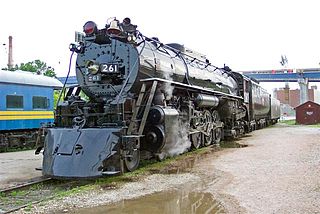
Milwaukee Road 261 is a class "S3" 4-8-4 "Northern" type steam locomotive built by the American Locomotive Company (ALCO) in Schenectady, New York in July 1944 for the Milwaukee Road.

The Boilermaker Special is the official mascot of Purdue University in West Lafayette, Indiana. It resembles a Victorian-era railroad locomotive and is built on a truck chassis. It is operated and maintained by the student members of the Purdue Reamer Club. It is often incorrectly assumed that Purdue Pete is the official mascot of the university.

The EMD BL2 is a model of diesel-electric locomotive built by General Motors Electro-Motive Division (EMD). A total of 58 units were built between 1947 and 1949. The BL2 was not very successful, as it was unreliable and occupied a gap between carbody and hood units, which resulted in it suffering from the drawbacks of both designs. However, lessons learned from the BL2 were incorporated into EMD's next design, the GP7.

EMD F-units are a line of diesel-electric locomotives produced between November 1939 and November 1960 by General Motors Electro-Motive Division and General Motors-Diesel Division. Final assembly for all F-units was at the GM-EMD plant at La Grange, Illinois, and the GMDD plant in London, Ontario. They were sold to railroads throughout the United States, Canada and Mexico, and a few were exported to Saudi Arabia. The term F-unit refers to the model numbers given to each successive type, all of which began with the letter F. The F originally meant "fourteen", as in 1,400 horsepower (1,000 kW), not "freight". Longer EMD E-units for passenger service had twin 900-horsepower (670 kW) diesel engines. The E meant "eighteen" as in 1,800 horsepower (1,300 kW). Similarly, for early model EMD switchers, S meant "six hundred" and N meant "nine hundred horsepower".

The EMD FL9 is a model of electro-diesel locomotive, capable of operating either as a traditional diesel-electric locomotive or as an electric locomotive powered from a third rail. Sixty units were built between October 1956 and November 1960 by General Motors Electro-Motive Division for the New York, New Haven and Hartford Railroad.
Early Electro-Motive Corporation switcher locomotives were built with Winton 201-A engines. A total of 175 were built between February 1935 and January 1939. Two main series of locomotives were built, distinguished by engine size and output: the straight-8, 600 hp (450 kW) 'S' series, and the V12, 900 hp (670 kW) 'N' series. Both were offered with either one-piece cast underframes from General Steel Castings of Granite City, Illinois, denoted by 'C' after the power identifier, and fabricated, welded underframes built by EMC themselves, denoted by 'W'. This gave four model series: SC, SW, NC and NW. Further developments of the 900 hp (670 kW) models gave model numbers NC1, NC2, NW1, and NW1A, all of which were practically indistinguishable externally from the others, as well as a pair of unique NW4 models for the Missouri Pacific Railroad and a solitary, twin-engined T transfer locomotive model built for the Illinois Central Railroad.
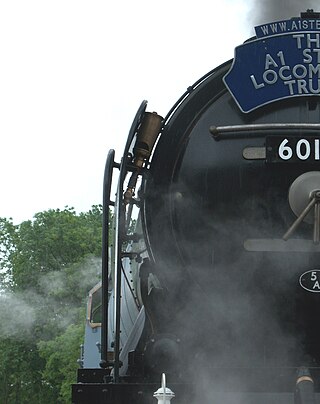
A train whistle or air whistle is an audible signaling device on a steam locomotive, used to warn that the train is approaching, and to communicate with rail workers. Modern diesel and electric locomotives primarily use a powerful air horn instead of a whistle as an audible warning device. However, the word whistle continues to be used by railroaders in referring to such signaling practices as "whistling off".

An EMD SW1200 is a four-axle diesel switcher locomotive built by General Motors Electro-Motive Division between January 1954 and May 1966. Power is provided by an EMD 567C 12-cylinder engine, which generates 1,200 horsepower (890 kW). Additional SW1200 production was completed by General Motors Diesel in Ontario, Canada, between September 1955 and June 1964.

A steam whistle is a device used to produce sound in the form of a whistle using live steam, which creates, projects, and amplifies its sound by acting as a vibrating system.

4489 Dominion of Canada is an LNER Class A4 steam locomotive. It is a 4-6-2 locomotive built to the same design by Sir Nigel Gresley as the more famous Mallard. There were 35 A4 locomotives built in total. Originally numbered 4489, it was renumbered 10 on 10 May 1946, under the LNER 1946 renumbering scheme of Edward Thompson and, after nationalisation in 1948, British Railways added 60000 to its number so it became 60010 on 27 October 1948. It was renumbered back to 4489 following a cosmetic restoration at the National Railway Museum in York during late 2012 and early 2013.

The ALCO RS-1 was a 4-axle diesel-electric locomotive built by Alco-GE between 1941 and 1953 and the American Locomotive Company from 1953 to 1960. ALCO subsidiary Montreal Locomotive Works built an additional three RS-1s in 1954. This model has the distinction of having the longest production run of any diesel locomotive for the North American market. The RS-1 was in production for 19 years from the first unit Rock Island #748 in March 1941 to the last unit National of Mexico #5663 in March 1960.
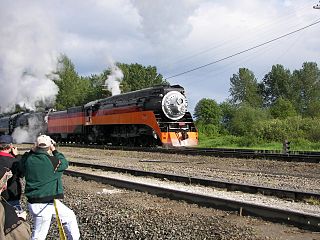
Southern Pacific 4449, also known as the Daylight, is the only surviving example of Southern Pacific Railroad's "GS-4" class of 4-8-4 "Northern" type steam locomotives and one of only two GS-class locomotives surviving, the other being "GS-6" 4460 at the National Museum of Transportation in St. Louis, Missouri. GS is an abbreviation of "General Service" or "Golden State," a nickname for California.
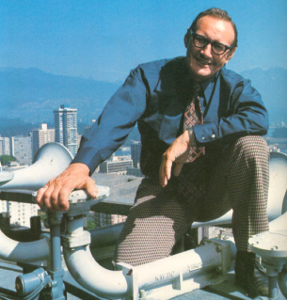
Robert Swanson (1905–1994) was a Canadian researcher and developer, and is credited with the invention of the first five and six-chime air horns for use on locomotives. Swanson had worked as the chief engineer of a company called Victoria Lumber Manufacturing in the 1920s, when he developed a hobby for making steam whistles for locomotives. Eventually, Swanson designed and built a large steam whistle for the mill where he worked. He also built the Heritage Horns that were on the old BC Hydro building that play the first four chords of "O Canada" at noon every day. The horns are now on the roof of the Pan Pacific hotel at Canada Place.
The RS1325 is a North American locomotive model built by Electro-Motive Division, having characteristics of both a switcher and a roadswitcher. Only two units were built.
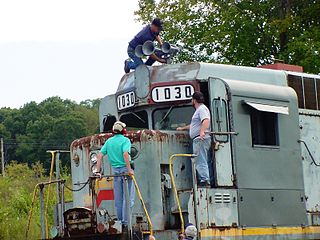
A train horn is an air horn used as an audible warning device on diesel and electric-powered trains. Its primary purpose is to alert persons and animals to an oncoming train, especially when approaching a level crossing. They are often extremely loud, allowing them to be heard from great distances. They are also used for acknowledging signals given by railroad employees, such as during switching operations. For steam locomotives, the equivalent device is a train whistle.

The QJ was a type of heavy freight steam locomotive introduced in 1956 by the China Railway. The majority were built by Datong Locomotive Factory. The prototypes and early production of the class were designated HP, being redesignated as FD class during the Cultural Revolution, before becoming the QJ class in 1971.

The ALCO RS-3m is a diesel-electric locomotive rebuilt from an ALCO RS-3 road switcher. These 98 locomotives were rebuilt to replace their original ALCO prime mover with the more reliable EMD 567B engine and fan assemblies taken from retired E8s. Many of these rebuilds were performed by the ex NYC DeWitt shop with 56 completed at the ex PRR Juniata shop. The RS3m rebuild program started in 1972 and continued until 1978 under Conrail.
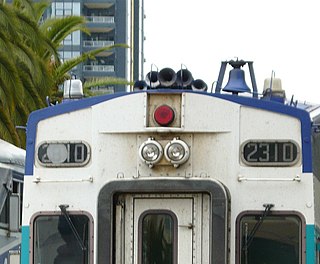
Nathan Manufacturing, Inc. is a division of Micro Precision Group which makes Airchime, Ltd. train horns mainly for North America. It is one of two major train horn manufacturers in the United States, with Leslie Controls, Inc. being the other.
Maine Central Railroad began operating diesel locomotives in 1935, and had retired all steam locomotives by 1954. That time interval was a joint operating period with the Boston and Maine Railroad (B&M). This article describes diesel locomotives owned by Maine Central through the period of joint operation and later independent operation prior to Guilford Rail System control in 1981.
















